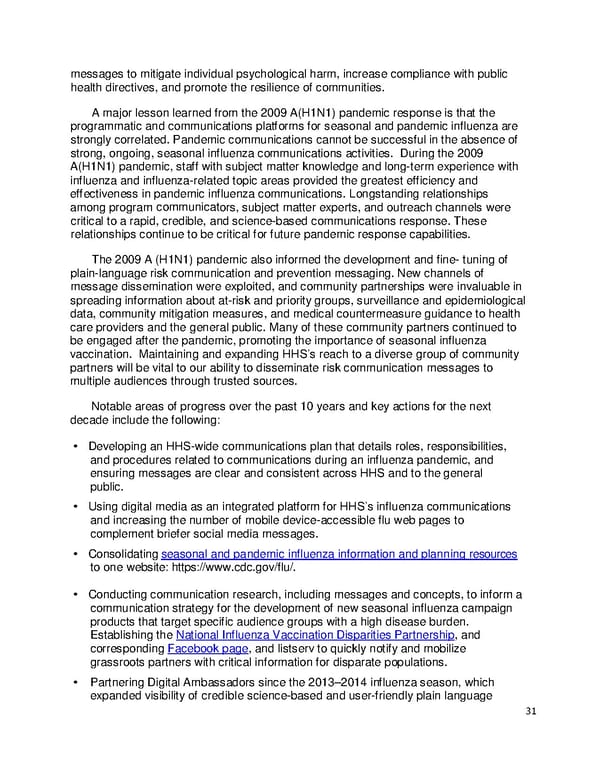messages to mitigate individual psychological harm, increase compliance with public health directives, and promote the resilience of communities. A major lesson learned from the 2009 A(H1N1) pandemic response is that the programmatic and communications platforms for seasonal and pandemic influenza are strongly correlated. Pandemic communications cannot be successful in the absence of strong, ongoing, seasonal influenza communications activities. During the 2009 A(H1N1) pandemic, staff with subject matter knowledge and long-term experience with influenza and influenza-related topic areas provided the greatest efficiency and effectiveness in pandemic influenza communications. Longstanding relationships among program communicators, subject matter experts, and outreach channels were critical to a rapid, credible, and science-based communications response. These relationships continue to be critical for future pandemic response capabilities. The 2009 A (H1N1) pandemic also informed the development and fine- tuning of plain-language risk communication and prevention messaging. New channels of message dissemination were exploited, and community partnerships were invaluable in spreading information about at-risk and priority groups, surveillance and epidemiological data, community mitigation measures, and medical countermeasure guidance to health care providers and the general public. Many of these community partners continued to be engaged after the pandemic, promoting the importance of seasonal influenza vaccination. Maintaining and expanding HHS’s reach to a diverse group of community partners will be vital to our ability to disseminate risk communication messages to multiple audiences through trusted sources. Notable areas of progress over the past 10 years and key actions for the next decade include the following: • Developing an HHS-wide communications plan that details roles, responsibilities, and procedures related to communications during an influenza pandemic, and ensuring messages are clear and consistent across HHS and to the general public. • Using digital media as an integrated platform for HHS’s influenza communications and increasing the number of mobile device-accessible flu web pages to complement briefer social media messages. • Consolidating seasonal and pandemic influenza information and planning resources to one website: https://www.cdc.gov/flu/. • Conducting communication research, including messages and concepts, to inform a communication strategy for the development of new seasonal influenza campaign products that target specific audience groups with a high disease burden. Establishing the National Influenza Vaccination Disparities Partnership, and corresponding Facebook page, and listserv to quickly notify and mobilize grassroots partners with critical information for disparate populations. • Partnering Digital Ambassadors since the 2013–2014 influenza season, which expanded visibility of credible science-based and user-friendly plain language 31
 Pandemic Influenza Plan Page 30 Page 32
Pandemic Influenza Plan Page 30 Page 32